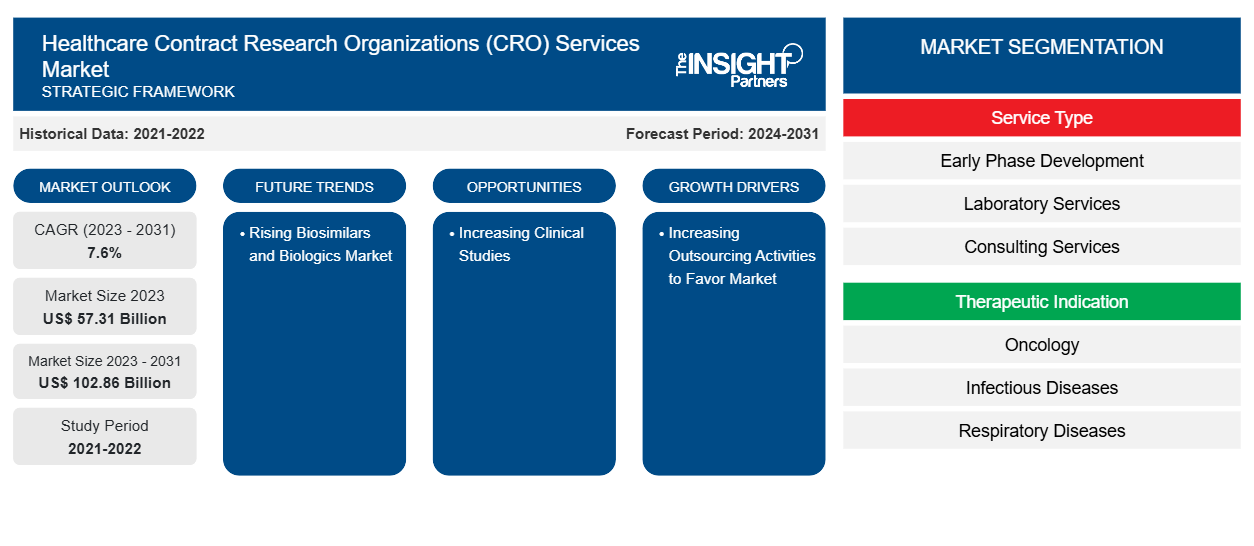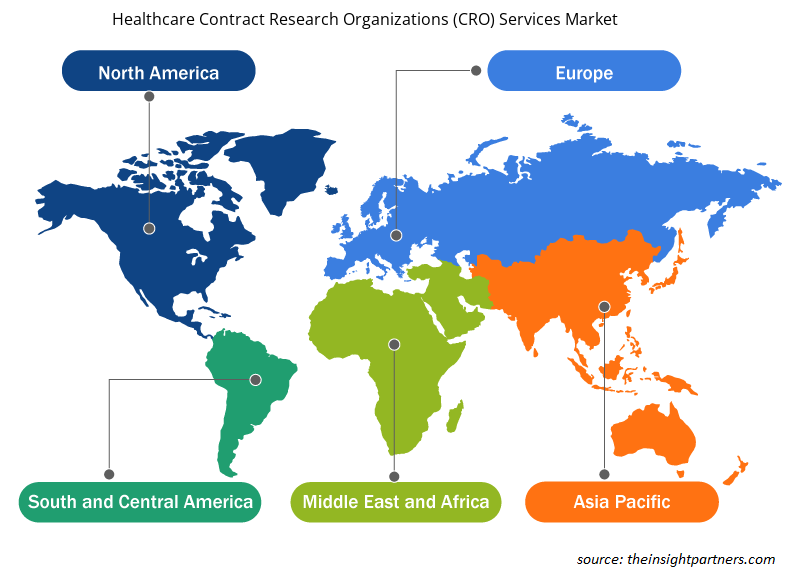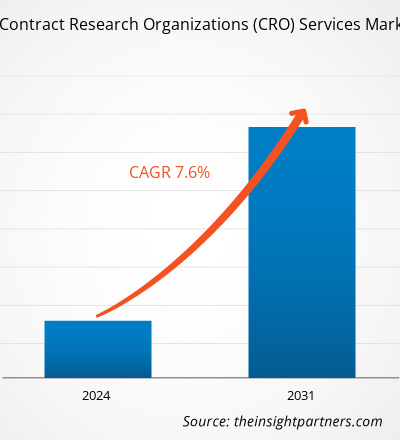Der Markt für Dienstleistungen von Auftragsforschungsinstituten im Gesundheitswesen (CRO) soll von 57,31 Milliarden US-Dollar im Jahr 2023 auf 102,86 Milliarden US-Dollar im Jahr 2031 anwachsen. Der Markt soll zwischen 2023 und 2031 eine durchschnittliche jährliche Wachstumsrate (CAGR) von 7,6 % verzeichnen. Die weltweit zunehmende Zahl klinischer Studien wird wahrscheinlich ein wichtiger Markttrend für Dienstleistungen von Auftragsforschungsinstituten im Gesundheitswesen (CRO) bleiben.
Marktanalyse für Dienstleistungen von Auftragsforschungsinstituten im Gesundheitswesen (CROs)
Faktoren wie die steigende Nachfrage nach neuen Medikamenten, die zunehmende Verbreitung chronischer Krankheiten und das Wachstum von Finanzierungsprogrammen zur Durchführung klinischer Studien sind für den Anstieg der Zahl klinischer Studien weltweit verantwortlich. Die Durchführung klinischer Studien erfordert erweiterte Forschungseinrichtungen, dedizierte Ressourcen und angemessene finanzielle Voraussetzungen. Diese Voraussetzungen für klinische Studien schaffen ein produktives Umfeld, um ein Auftragsforschungsinstitut für die Durchführung klinischer Studien zu bevorzugen. Die oben genannten Faktoren werden das Marktwachstum im Prognosezeitraum ankurbeln.
Marktübersicht für Auftragsforschungsinstitute im Gesundheitswesen (CROs)
Pharma- und Biotech-Unternehmen konzentrieren sich auf F&E-Aktivitäten, um neue Moleküle und therapeutische Plattformen für chronische Krankheiten zu entwickeln. Asthma ist die häufigste chronische Krankheit bei Kindern weltweit und die WHO schätzt, dass weltweit etwa 263 Millionen Menschen an Asthma leiden. Die zunehmende Verbreitung chronischer Krankheiten wird daher wahrscheinlich zur Entwicklung neuer Arzneimittel führen, was das Wachstum des Marktes für Auftragsforschungsinstitute im Gesundheitswesen (CROs) weiter beschleunigen wird.
Passen Sie diesen Bericht Ihren Anforderungen an
Sie erhalten kostenlos individuelle Anpassungen an jedem Bericht, einschließlich Teilen dieses Berichts oder einer Analyse auf Länderebene, eines Excel-Datenpakets sowie tolle Angebote und Rabatte für Start-ups und Universitäten.
Markt für Dienstleistungen von Auftragsforschungsinstituten im Gesundheitswesen (CRO): Strategische Einblicke

- Holen Sie sich die wichtigsten Markttrends aus diesem Bericht.Dieses KOSTENLOSE Beispiel umfasst eine Datenanalyse von Markttrends bis hin zu Schätzungen und Prognosen.
Treiber und Chancen auf dem Markt für Auftragsforschungsinstitute im Gesundheitswesen (CRO)
Steigende Outsourcing-Aktivitäten zur Förderung des Marktes
Viele Unternehmen gehen strategische Partnerschaften mit Auftragsforschungsinstituten ein. So ging Aragen Bioscience, Inc., eine Tochtergesellschaft von GVK BIO, einem der bedeutenden Akteure im präklinischen CRO-Bereich, im Januar 2020 eine strategische Zusammenarbeit mit Serum Institute of India Pvt. Ltd. ein, um die Forschung und Entwicklung mehrerer stabiler Zelllinien im Rahmen des HIV-Programms von Serum zu beschleunigen. Darüber hinaus wird Labcorp im Jahr 2022 sein CRO-Segment namens Fortrea ausgliedern, das „Studien mit Leichtigkeit vorantreiben“ soll, als unabhängiges, börsennotiertes CRO arbeiten und Arzneimittel- und Medizinproduktedienste anbieten, darunter Angebote zur Verwaltung klinischer Studien und Vermarktung.Aragen Bioscience, Inc, a subsidiary of GVK BIO, one of the significant players in pre-clinical CRO, entered into a strategic collaboration with Serum Institute of India Pvt. Ltd. to accelerate the R&D of multiple stable cell lines under Serum’s HIV program. Moreover, In 2022, Labcorp spin off its CRO segment, named Fortrea, which stands to “forward trials with ease” will work as an independent publicly traded CRO, and provide drug and medical device services, including clinical trial management and commercialization offerings.
Wachsender Markt für Biosimilars und Biologika – eine Chance für den Dienstleistungsmarkt für Auftragsforschungsinstitute im Gesundheitswesen (CROs)Biosimilars and Biologics Market – An Opportunity in Healthcare Contract Research Organizations (CRO) Services Market
Die Biotechnologiebranche erweitert den Werkzeugkasten der Wissenschaftler, und die Kombination aus Grundlagenforschung, translationalen Studien und klinischen Studien wird weiterhin zusätzliche Verbindungen, Techniken und Therapiewege entwickeln, untersuchen und testen. Die Biotechnologie ist ein strategischer Sektor für China. Die Initiative „Made in China 2025“ zielt darauf ab, Hightech-Produkte, darunter innovative Medikamente, herzustellen. Der Plan führte Ziele für chinesische Pharmaunternehmen ein, um Innovationen in der Biotechnologie voranzutreiben und die Exporte zu steigern. Darüber hinaus nutzen diese asiatischen Länder Fortschritte in den Bereichen Genomik, Proteomik und Biomarker für diagnostische und therapeutische Anwendungen. Daher wird die fortschreitende Entwicklung der Biotechnologiebranche in Entwicklungsregionen in den kommenden Jahren Chancen für den Markt für Biologika und Biosimilars schaffen.
Marktbericht zu Vertragsforschungsorganisationen (CRO) im Gesundheitswesen – Segmentierungsanalyse
Wichtige Segmente, die zur Ableitung der Marktanalyse für Dienstleistungen von Auftragsforschungsinstituten im Gesundheitswesen (CRO) beitragen, sind Servicetyp, therapeutische Indikation und Endbenutzer.
- Basierend auf der Art der Dienstleistung ist der Markt für Auftragsforschungsinstitute im Gesundheitswesen (CRO) in Frühphasenentwicklung, Labordienstleistungen, Beratungsdienste und klinische Forschungsdienstleistungen unterteilt. Das Segment der klinischen Forschungsdienstleistungen hatte im Jahr 2023 einen größeren Marktanteil.
- Basierend auf der therapeutischen Indikation ist der Markt in Onkologie, Infektionskrankheiten, Atemwegserkrankungen, Herz-Kreislauf-Erkrankungen , neurologische Erkrankungen und andere unterteilt. Das Segment „Sonstige“ hatte im Jahr 2023 einen größeren Marktanteil.
- In Bezug auf den Endverbraucher ist der Markt in Medizinprodukteunternehmen, Pharma- und Biopharmaunternehmen und andere segmentiert. Das Segment der Pharma- und Biopharmaunternehmen dominierte den Markt im Jahr 2023.
Marktanteilsanalyse für Auftragsforschungsinstitute im Gesundheitswesen (CRO) nach geografischer Lage
Der geografische Umfang des Marktberichts zu Dienstleistungen von Auftragsforschungsinstituten im Gesundheitswesen (CRO) ist hauptsächlich in fünf Regionen unterteilt: Nordamerika, Europa, Asien-Pazifik, Naher Osten und Afrika sowie Süd- und Mittelamerika. Der Markt für Dienstleistungen von Auftragsforschungsinstituten im Gesundheitswesen (CRO) ist in Nordamerika bedeutend. In Nordamerika wird das Wachstum des Marktes für Dienstleistungen von Auftragsforschungsinstituten im Gesundheitswesen (CRO) hauptsächlich durch hohe regulatorische Standards der Pharmaindustrie, eine steigende Zahl klinischer Studien und das schnelle Wachstum des Marktes für Biosimilars und Biologika vorangetrieben. Marge-Pharmaunternehmen werden ihre F&E-Ausgaben voraussichtlich um 4 % pro Jahr, d. h. 234 Milliarden US-Dollar bis 2025, steigern. Ebenso wird für die F&E-Ausgaben im Bereich Biotechnologie ein Anstieg von bis zu 8 % pro Jahr prognostiziert. Die oben genannten Faktoren werden sich voraussichtlich positiv auf das Wachstum des Marktes für Dienstleistungen von Auftragsforschungsinstituten im Gesundheitswesen (CRO) auswirken.
Regionale Einblicke in den Markt für Auftragsforschungsinstitute (CROs) im Gesundheitswesen
Die regionalen Trends und Faktoren, die den Markt für Auftragsforschungsinstitute im Gesundheitswesen (CRO) im gesamten Prognosezeitraum beeinflussen, wurden von den Analysten von Insight Partners ausführlich erläutert. In diesem Abschnitt werden auch die Marktsegmente und die Geografie von Auftragsforschungsinstituten im Gesundheitswesen (CRO) in Nordamerika, Europa, im asiatisch-pazifischen Raum, im Nahen Osten und Afrika sowie in Süd- und Mittelamerika erörtert.

- Erhalten Sie regionale Daten zum Markt für Auftragsforschungsinstitute im Gesundheitswesen (CRO)
Umfang des Marktberichts zu Dienstleistungen von Auftragsforschungsinstituten im Gesundheitswesen (CRO)
| Berichtsattribut | Details |
|---|---|
| Marktgröße im Jahr 2023 | 57,31 Milliarden US-Dollar |
| Marktgröße bis 2031 | 102,86 Milliarden US-Dollar |
| Globale CAGR (2023 - 2031) | 7,6 % |
| Historische Daten | 2021-2022 |
| Prognosezeitraum | 2024–2031 |
| Abgedeckte Segmente | Nach Servicetyp
|
| Abgedeckte Regionen und Länder | Nordamerika
|
| Marktführer und wichtige Unternehmensprofile |
|
Dichte der Marktteilnehmer für Auftragsforschungsinstitute im Gesundheitswesen (CRO): Auswirkungen auf die Geschäftsdynamik verstehen
Der Markt für Dienstleistungen von Auftragsforschungsinstituten im Gesundheitswesen (CRO) wächst rasant. Dies wird durch die steigende Nachfrage der Endnutzer aufgrund von Faktoren wie sich entwickelnden Verbraucherpräferenzen, technologischen Fortschritten und einem größeren Bewusstsein für die Vorteile des Produkts vorangetrieben. Mit der steigenden Nachfrage erweitern Unternehmen ihr Angebot, entwickeln Innovationen, um die Bedürfnisse der Verbraucher zu erfüllen, und nutzen neue Trends, was das Marktwachstum weiter ankurbelt.
Die Marktteilnehmerdichte bezieht sich auf die Verteilung der Firmen oder Unternehmen, die in einem bestimmten Markt oder einer bestimmten Branche tätig sind. Sie gibt an, wie viele Wettbewerber (Marktteilnehmer) in einem bestimmten Marktraum im Verhältnis zu seiner Größe oder seinem gesamten Marktwert präsent sind.
Die wichtigsten Unternehmen auf dem Markt für Auftragsforschungsinstitute im Gesundheitswesen (CROs) sind:
- Charles River Laboratories Inc.
- IQVIA Inc.
- Laboratorium Corporation of America Holdings
- Parexel International Corporation
- Symbol Plc.
- Pra Gesundheitswissenschaften
Haftungsausschluss : Die oben aufgeführten Unternehmen sind nicht in einer bestimmten Reihenfolge aufgeführt.

- Überblick über die wichtigsten Akteure auf dem Markt für Auftragsforschungsinstitute im Gesundheitswesen (CRO)
Neuigkeiten und aktuelle Entwicklungen zum Markt für Auftragsforschungsinstitute im Gesundheitswesen
Der Markt für Dienstleistungen von Auftragsforschungsinstituten im Gesundheitswesen (CRO) wird durch die Erfassung qualitativer und quantitativer Daten nach Primär- und Sekundärforschung bewertet, die wichtige Unternehmensveröffentlichungen, Verbandsdaten und Datenbanken umfasst. Im Folgenden finden Sie eine Liste der Entwicklungen auf dem Markt für Innovationen, Geschäftserweiterungen und Strategien:
- Im Juni 2021 unterzeichnete LINK Medical, ein Full-Service-Auftragsforschungsinstitut (CRO) für die Pharma- und Medizinprodukteindustrie, einen Vertrag zur Zusammenarbeit mit Insife, einem kompetenten Beratungs- und Technologiedienstleister für Sicherheits- und Pharmakovigilanzorganisationen. (Quelle: LINK Medical, Pressemitteilung)
- Im April 2020 startete Accelerated Enrollment Solutions (AES), ein Unternehmen von PPD, Inc., ein neues Programm, das biopharmazeutischen Unternehmen dabei helfen soll, ihre Geschäftskontinuität während der globalen COVID-19-Pandemie aufrechtzuerhalten, indem Patienten aus klinischen Studien von anderen Forschungseinrichtungen, die von der Coronavirus-Krise betroffen sind, an die speziellen Forschungsstandorte von AES verlegt werden. (Quelle: PPD, Inc., Newsletter)
Marktbericht zu Dienstleistungen von Auftragsforschungsinstituten im Gesundheitswesen (CROs) – Umfang und Ergebnisse
Der Bericht „Marktgröße und Prognose für Vertragsforschungsorganisationen (CRO) im Gesundheitswesen (2021–2031)“ bietet eine detaillierte Analyse des Marktes, die die folgenden Bereiche abdeckt:
- Marktgröße und Prognose für Dienstleistungen im Bereich Auftragsforschung im Gesundheitswesen (CRO) auf globaler, regionaler und Länderebene für alle wichtigen Marktsegmente, die im Rahmen des Berichts abgedeckt sind
- Marktdynamik wie Treiber, Beschränkungen und wichtige Chancen
- Markttrends für Dienstleistungen von Auftragsforschungsinstituten im Gesundheitswesen (CROs)
- Detaillierte PEST- und SWOT-Analyse
- Markt für Dienstleistungen im Bereich Auftragsforschungsorganisationen im Gesundheitswesen (CRO), der wichtige Markttrends, globale und regionale Rahmenbedingungen, wichtige Akteure, Vorschriften und aktuelle Marktentwicklungen umfasst
- Branchenlandschaft und Wettbewerbsanalyse für Auftragsforschungsinstitute im Gesundheitswesen (CROs), einschließlich Marktkonzentration, Heatmap-Analyse, prominenten Akteuren und aktuellen Entwicklungen
- Detaillierte Firmenprofile
- Historische Analyse (2 Jahre), Basisjahr, Prognose (7 Jahre) mit CAGR
- PEST- und SWOT-Analyse
- Marktgröße Wert/Volumen – Global, Regional, Land
- Branchen- und Wettbewerbslandschaft
- Excel-Datensatz
Aktuelle Berichte
Erfahrungsberichte
Grund zum Kauf
- Fundierte Entscheidungsfindung
- Marktdynamik verstehen
- Wettbewerbsanalyse
- Kundeneinblicke
- Marktprognosen
- Risikominimierung
- Strategische Planung
- Investitionsbegründung
- Identifizierung neuer Märkte
- Verbesserung von Marketingstrategien
- Steigerung der Betriebseffizienz
- Anpassung an regulatorische Trends




















 Kostenlose Probe anfordern für - Markt für Dienstleistungen von Auftragsforschungsinstituten im Gesundheitswesen (CRO)
Kostenlose Probe anfordern für - Markt für Dienstleistungen von Auftragsforschungsinstituten im Gesundheitswesen (CRO)